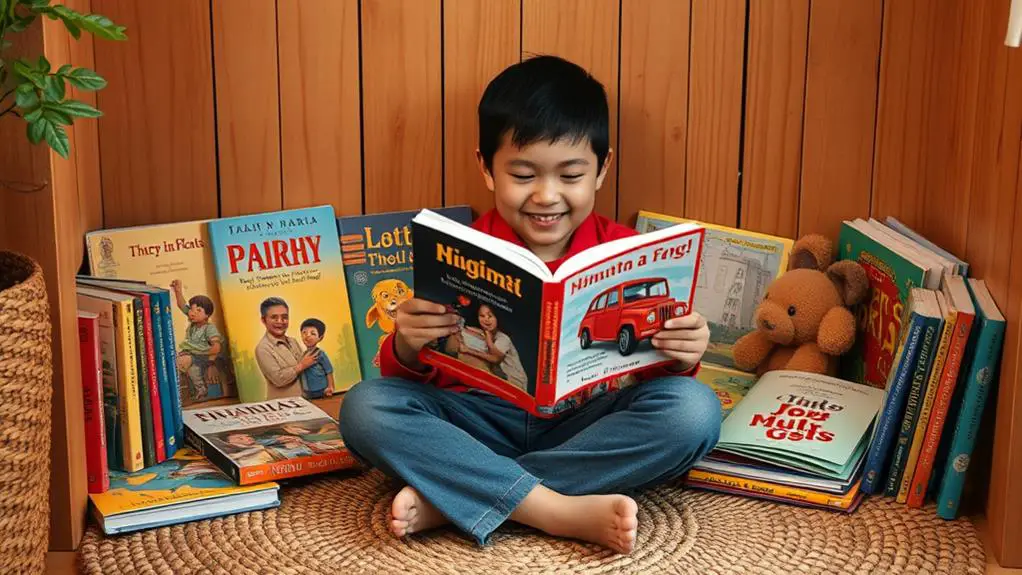Improve Your Tagalog Speaking Skills with These Engaging Activities
Read Aloud and Create Conversations
Reading bilingual books aloud helps you practice your pronunciation and intonation in Tagalog.
Additionally, creating arts and crafts conversations with a language partner or tutor enables you to engage in spontaneous discussions and build your speaking confidence.
Build Vocabulary with Games and Technology
Playing vocabulary building games, such as matching words to their meanings or using flashcards, enhances your vocabulary in Tagalog.
You can also utilize language learning apps that offer interactive speaking exercises and quizzes to test your skills.
Sing Along to Filipino Music and Cook with Recipes
Singing along to Filipino music with Tagalog lyrics helps you learn new words and phrases in context.
Moreover, cooking and learning with recipes in Tagalog provides a real-life context to practice your vocabulary and pronunciation.
Listen to Audio Stories and Engage in Interactive Storytelling
Listening to Tagalog audio stories exposes you to different speaking styles and pronunciation.
Participating in interactive storytelling sessions with a language partner or tutor allows you to practice your speaking skills in a more dynamic and engaging way.
These activities will help you improve your Tagalog speaking skills and provide a solid foundation for further language development.
Read Bilingual Books Aloud

Reading bilingual books aloud is an effective way to practice speaking Tagalog. This is especially true when reading Filipino children's stories that feature both Tagalog and English. As you read, you'll be exposed to both languages simultaneously, which enhances vocabulary acquisition.
The selection of Filipino/Fil-Am children's books is expanding. Notable sources like Tahanan Books and Adarna House provide rich content for reading sessions. These books not only improve language skills but also foster cultural familiarity and appreciation.
Bilingual picture books are valuable resources. You can find them at your local library, which often carries a varied selection of bilingual books. Reading aloud encourages interaction, allowing you to ask questions and discuss the story, further reinforcing your understanding and retention of Tagalog vocabulary.
Incorporating bilingual books into your learning routine is essential. By doing so, you'll be well on your way to learning Filipino and developing a deeper connection to the culture.
Create Arts & Crafts Conversations
Crafting Conversations in Tagalog
While creating arts and crafts, you're not only producing a tangible product, but you're also generating opportunities to practice speaking Tagalog. This approach to language learning enables you to discuss colors, shapes, and materials in Tagalog, enhancing your vocabulary through contextual conversations.
Interactive Environment
Engaging in craft activities places you in a fun and interactive environment where you can practice speaking Tagalog while creating something with your own hands. By following instructions in Tagalog, you'll develop your listening skills and comprehension by understanding and executing tasks in the language.
Elevating Your Tagalog Learning Experience
Explore cultural motifs by using Tagalog-themed craft ideas to delve into Filipino traditions and vocabulary. For example, you can create a paper fan with a traditional Filipino design, such as the baybayin alphabet.
Discuss cultural significance by talking about the meaning behind the crafts you're making to deepen your understanding and appreciation of Filipino culture. For instance, you can discuss the significance of the parol, a star-shaped Christmas decoration, in Filipino culture.
Practice vocabulary by engaging in conversations about colors, shapes, and materials in Tagalog to improve your vocabulary. You can describe the colors and shapes of the materials you're using, such as kulay (color) and hugis (shape).
Get inspired online by following Filipino artists and crafters on social media platforms like Instagram to discover new ideas and inspiration for your Tagalog-themed crafts. You can search for hashtags like #FilipinoCrafts or #TagalogArts to find inspiration.
Play Vocabulary Building Games

Vocabulary building games are an effective way to learn and retain Tagalog vocabulary. These games create a supportive learning atmosphere, fostering collaboration among learners and enhancing language skills.
For example, games like Memory and Charades can be tailored to focus on specific vocabulary categories, such as household items, family terms, or colors, making learning relevant and enjoyable.
Visual aids and flashcards can be incorporated into vocabulary games to enhance memorization and understanding of Tagalog words and phrases.
Consistent practice through these games improves language skills and boosts motivation and interest in learning the Filipino language.
Regular play leads to increased confidence in using Tagalog in everyday conversations.
Engage With Language Learning Apps
Your smartphone can be a valuable language learning companion, and engaging with language learning apps is an excellent way to practice speaking Tagalog. These apps offer a convenient and enjoyable way to learn Tagalog words and phrases on-the-go.
Language learning apps provide interactive lessons that make learning Tagalog fun and engaging. For example, apps like Gus on the Go and FilipinoPod101 offer interactive lessons that teach Tagalog vocabulary and grammar.
Improve pronunciation with language learning apps that include audio pronunciation features. These features allow you to hear native speakers and improve your speaking and listening skills in Tagalog.
Gamification is a key feature of language learning apps, which provide gamified experiences that track your progress and maintain motivation. This encourages regular practice in speaking Tagalog.
Language learning apps also offer contextual learning through educational videos that allow you to contextualize your language practice. This further aids in the development of conversational skills in Tagalog.
Sing Along to Filipino Music

Singing along to Filipino music improves pronunciation and listening skills. This fun and engaging way to practice speaking Tagalog allows you to immerse yourself in the Filipino culture while enjoying catchy tunes.
YouTube channels like Pinoy Babies & Kids and Robie317 offer a variety of children's songs in Tagalog that you can sing along to.
Using lyrics sheets enhances comprehension and retention. By following along with the lyrics, you can understand the meaning of the songs, which helps you learn new vocabulary and phrases.
Setting a monthly song theme provides a structured learning opportunity. This allows you to explore different vocabulary and cultural aspects related to each song.
Regularly incorporating music into your language practice makes learning Tagalog more enjoyable and motivating.
Cook and Learn With Recipes
Flavors of the Philippines await as you cook and learn with recipes, a delicious way to practice speaking Tagalog.
Cooking and learning recipes is an effective way to practice speaking Tagalog. As you cook, you'll learn essential vocabulary related to ingredients and cooking techniques, such as "sibuyas" (onion) and "luto" (to cook). Discussing Filipino food culture during cooking sessions can enrich your language learning experience and promote cultural appreciation.
Cooking can help you practice speaking Tagalog in four ways:
Family bonding occurs when you cook together, creating real-life contexts for using Tagalog and enhancing both language skills and family bonding. For instance, you can ask your family members "Anong gusto mo?" (What do you want?) or "Kailangan mo ba ng tulong?" (Do you need help?).
Cultural immersion is achieved through educational videos, like those from FilipinoPod101, which provide practical language applications and reinforce vocabulary in a fun, engaging manner. You can watch videos that demonstrate how to cook traditional Filipino dishes while listening to Tagalog instructions.
Dynamic language learning occurs when recipes are adapted to include Tagalog instructions, making the cooking process a dynamic language learning activity. For example, you can replace "add salt" with "dagdagan ng asin" in a recipe.
Vocabulary building happens when you involve children in cooking, allowing them to learn Tagalog vocabulary related to ingredients and cooking techniques, such as "bigas" (rice) and "luto" (to cook).
How Can Connecting With Native Speakers Enhance Tagalog Speaking Activities?
Connecting with native speakers offers an immersive experience that enriches Tagalog speaking activities. By engaging in real conversations, learners gain authentic exposure to pronunciation, cultural nuances, and idiomatic expressions. Regular tagalog language practice with native speakers builds confidence, improves fluency, and fosters deeper connections while mastering the language in its natural context.
Listen to Tagalog Audio Stories

Immerse yourself in Tagalog storytelling through engaging audio stories that bring the language to life. These stories introduce a range of themes, from fairy tales to educational lessons, catering to diverse interests and promoting listening skills. For example, collections like "Tagalog Short Stories for Kids" offer entertaining narratives tailored for young learners.
Regular exposure to Tagalog audio content reinforces grammatical structures and vocabulary in a natural context, supporting language acquisition. This is because audio stories provide a context for language learners to practice listening comprehension and pick up new words and phrases. Many audio stories are available for free online, making them accessible resources for families and educators aiming to enrich Tagalog language learning.
Consistently listening to Tagalog audio stories fosters a love for the language and cultural heritage. This is especially important for Filipino children, as it helps them connect with their roots and appreciate their cultural legacy.
Frequently Asked Questions
How Can I Practice Speaking Tagalog?
Find a Language Partner or Join a Speaking Club
To practice speaking Tagalog, find a language exchange partner or join speaking clubs where you can interact with native speakers or fellow learners. This will help you build confidence and get comfortable with the language.
For example, you can search for language exchange websites, social media groups, or local language meetups in your area.
Record Yourself Speaking
Record yourself speaking Tagalog and listen to the playback to improve your pronunciation. This will allow you to identify areas for improvement and track your progress over time.
You can use a voice recorder app on your phone or computer to record yourself speaking.
How to Become Fluent in Tagalog?
Immerse yourself in the language to become fluent in Tagalog. This can be achieved by listening to Filipino podcasts, which will help you get accustomed to the sounds, rhythms, and intonations of the language. For example, you can start with popular podcasts like "The Filipino Podcast" or "Tagalog Podcast".
Watch Tagalog films with English subtitles to improve your comprehension and vocabulary. This will also help you learn cultural nuances and context-specific expressions. Try watching Filipino movies on Netflix or YouTube with subtitles.
Practice speaking with native conversational partners regularly to build confidence in your speaking skills. You can find language exchange partners online through platforms like italki or Conversation Exchange. Set aside time each week to practice speaking with a native speaker.
Consistency is key to achieving fluency in Tagalog. Set aside time each day to practice listening, watching, and speaking in Tagalog.
With dedication and persistence, you'll be well on your way to becoming fluent in Tagalog.
Are Filipino and Tagalog the Same?
Filipino and Tagalog aren't exactly identical.
Tagalog has a rich history as a dialect spoken in the Philippines. Filipino is the standardized form of Tagalog, incorporating elements from other Philippine languages. This means that Filipino is the national language, while Tagalog is a dialect.
Filipino has a broader vocabulary and is used in formal contexts, such as education, government, and media.
Tagalog is commonly spoken in everyday conversations, particularly in the Metro Manila region and surrounding areas.
How to Learn Filipino Language for Free?
Language Exchange Websites
To learn Filipino for free, start by utilizing online language exchange websites. These platforms connect you with native Filipino speakers who want to learn your native language in exchange for helping them. For example, italki and Conversation Exchange allow you to find language partners and practice speaking with them.
Free Online Resources
Explore free online resources that cater to various learning styles. Digital Dialects offers interactive language exercises, while YouTube channels like Learn Tagalog with Kay provide video lessons and explanations. You can also use vocabulary quizzes like Quizlet to test your knowledge.
Online Communities and Forums
Join online communities and forums focused on Tagalog language learning to connect with others and share resources. For instance, Reddit's r/Tagalog and Facebook groups dedicated to Filipino language learners provide a platform to ask questions, share materials, and get feedback from other learners.